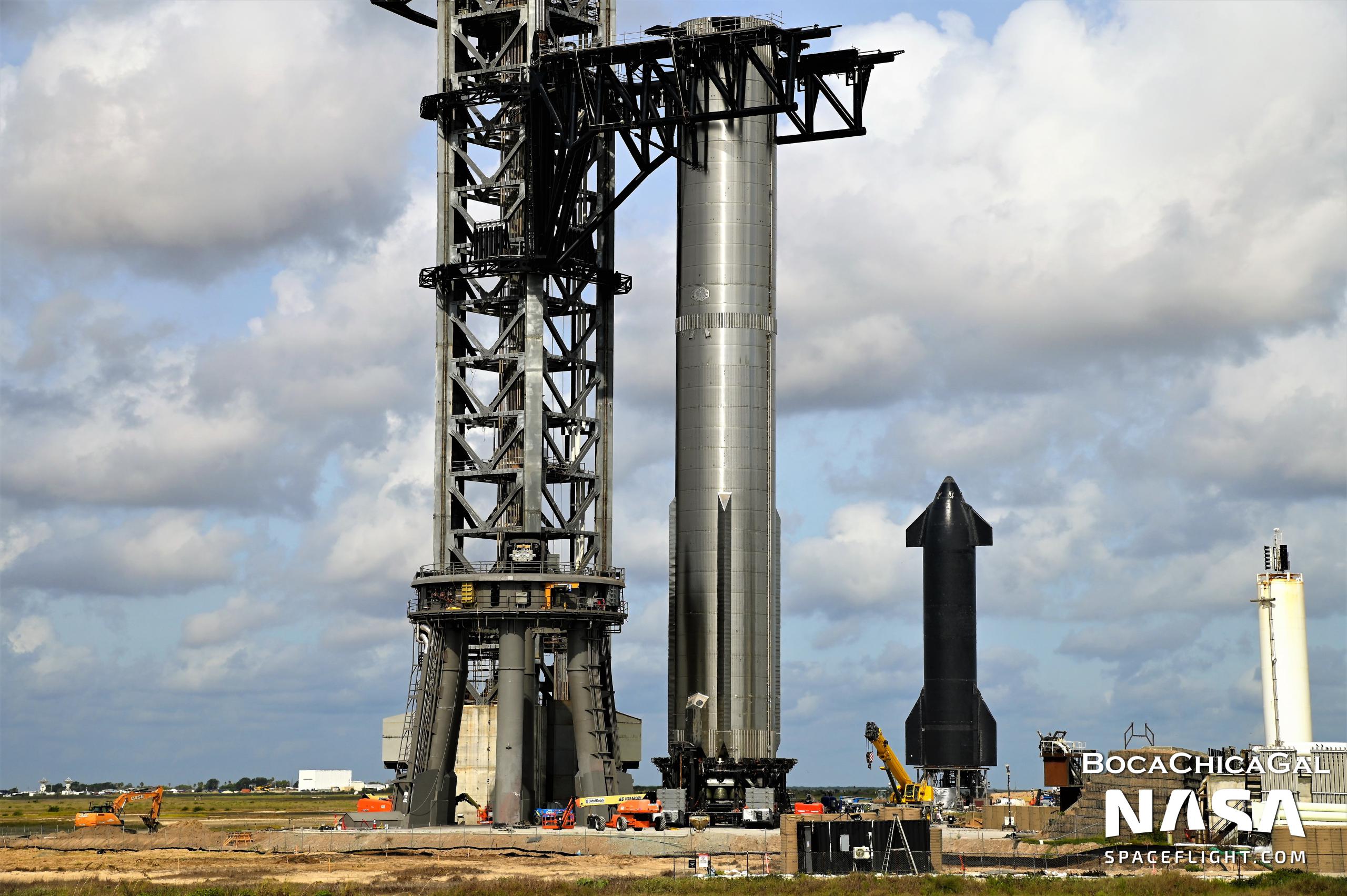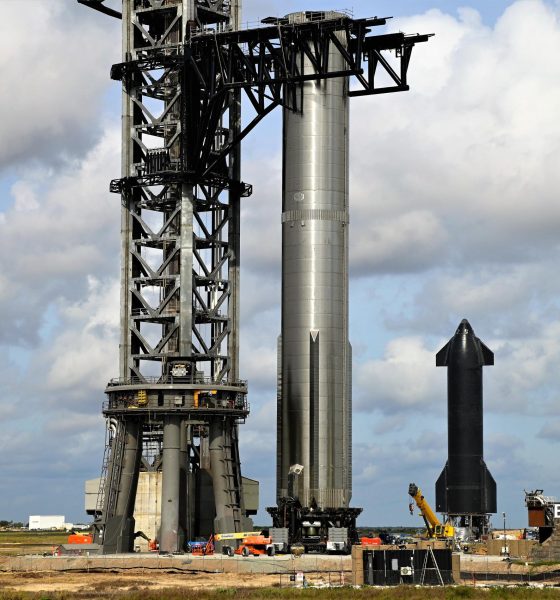

News
SpaceX Starship booster heads to launch pad for the fifth time
For the fifth time in five months, SpaceX has transported its most advanced Starship booster prototype from the Starbase factory to the launch pad, setting the stage for another round of testing.
Super Heavy Booster 7 (B7) returned to the factory for the fourth time on August 12th after becoming the first prototype of any kind to perform a static fire engine test while installed on SpaceX’s orbital Starship launch mount. In the days prior, the booster completed two back-to-back static fire tests with one of the 20 Raptor engines installed on the rocket, both of which apparently gave SpaceX enough confidence to prepare for the next phase of testing.
That relatively cautious progress only came after SpaceX attempted to test all 33 of the prototype’s Raptors at once during its first engine test. Whether it was the fault of overzealous managers or executives or a genuine oversight is not clear, but the combined behavior of Super Heavy and the orbital launch pad was not properly characterized before testing began. As a result, the cloud of flammable gas the rocket released during its attempted 33-engine ‘spin-prime’ test found an ignition source and violently exploded on July 11th, causing damage throughout Booster 7’s aft engine section that required several weeks of repairs between July 15th and August 6th.
When the Super Heavy rolled to the pad for the fourth time on August 6th, it was missing all 13 center Raptors, leaving only the outer ring of 20 Raptor Boost engines partially installed for the tests that followed. Thankfully, things went much better on the second try and Booster 7 completed two spin-prime tests with a single Raptor engine, followed by two successful static fire tests on August 9th and 11th. The latter test was the longest Starbase static fire ever (by a factor of ~3) and lasted about 20 seconds, allowing SpaceX to test Booster 7’s autogenous pressurization. That system pressurizes Super Heavy’s tanks by turning small quantities of cryogenic liquid propellant into gas, ensuring that its tanks remain stable as they’re rapidly drained of thousands of tons of propellant.
On August 12th, Booster 7 returned to the factory, where workers installed the rocket’s 13 center engines for the second time. Booster 7 headed back to the orbital launch site (OLS) on August 23rd and the pad’s robotic launch tower used a pair of arms to lift the rocket off its transport stand and place it on the launch mount by the end of the day.
In addition to readying Booster 7 for its next phase of static fire testing, teams of SpaceX workers took advantage of the unplanned lull in testing to modify the orbital launch mount. It’s impossible to know what exactly was done without official confirmation, but it’s likely that SpaceX was attempting to quickly fix the shortcoming(s) that allowed the July 11th explosion to happen. Without a fix, it’s unlikely that SpaceX would want to proceed with plans to ignite large numbers of Raptor engines simultaneously – a series of tests that must be completed before Starship can safely attempt its first orbital launch.


It’s unclear what exactly that fix entails, but it could involve a system to constantly flood the engine section with fire-stopping nitrogen gas or potentially take the shape of a system of vents that will connect to every Raptor engine and remove methane gas before it can turn into flammable clouds.
It’s possible that Booster 7 has returned to the launch pad solely for fit checks or some other basic proof-of-concept testing. It’s also possible that the returns signifies that SpaceX is confident in its quick launch mount fix and ready to restart static fire testing.
As Booster 7 prepares for that next phase of testing, SpaceX may also be ready to restart static fire testing with Starship S24, which paused shortly before Super Heavy returned to the factory. SpaceX appears to be modifying the suborbital launch mount and test stand Ship 24 is installed on, which could explain the lack of ship testing since August 11th. SpaceX has 12-hour test windows tentatively scheduled on August 24th and 25th, either of which could be used to test either or both prototypes.
If all goes to plan, Ship 24 and Booster 7 will eventually complete all the qualification testing SpaceX can throw at them and be ready to support Starship’s first orbital launch attempt sometime before the end of 2022.

Elon Musk
Elon Musk and Tesla AI Director share insights after empty driver seat Robotaxi rides
The executives’ unoccupied tests hint at the rapid progress of Tesla’s unsupervised Robotaxi efforts.

Tesla CEO Elon Musk and AI Director Ashok Elluswamy celebrated Christmas Eve by sharing personal experiences with Robotaxi vehicles that had no safety monitor or occupant in the driver’s seat. Musk described the system’s “perfect driving” around Austin, while Elluswamy posted video from the back seat, calling it “an amazing experience.”
The executives’ unoccupied tests hint at the rapid progress of Tesla’s unsupervised Robotaxi efforts.
Elon and Ashok’s firsthand Robotaxi insights
Prior to Musk and the Tesla AI Director’s posts, sightings of unmanned Teslas navigating public roads were widely shared on social media. One such vehicle was spotted in Austin, Texas, which Elon Musk acknowleged by stating that “Testing is underway with no occupants in the car.”
Based on his Christmas Eve post, Musk seemed to have tested an unmanned Tesla himself. “A Tesla with no safety monitor in the car and me sitting in the passenger seat took me all around Austin on Sunday with perfect driving,” Musk wrote in his post.
Elluswamy responded with a 2-minute video showing himself in the rear of an unmanned Tesla. The video featured the vehicle’s empty front seats, as well as its smooth handling through real-world traffic. He captioned his video with the words, “It’s an amazing experience!”
Towards Unsupervised operations
During an xAI Hackathon earlier this month, Elon Musk mentioned that Tesla owed be removing Safety Monitors from its Robotaxis in Austin in just three weeks. “Unsupervised is pretty much solved at this point. So there will be Tesla Robotaxis operating in Austin with no one in them. Not even anyone in the passenger seat in about three weeks,” he said. Musk echoed similar estimates at the 2025 Annual Shareholder Meeting and the Q3 2025 earnings call.
Considering the insights that were posted Musk and Elluswamy, it does appear that Tesla is working hard towards operating its Robotaxis with no safety monitors. This is quite impressive considering that the service was launched just earlier this year.
Elon Musk
Starlink passes 9 million active customers just weeks after hitting 8 million
The milestone highlights the accelerating growth of Starlink, which has now been adding over 20,000 new users per day.

SpaceX’s Starlink satellite internet service has continued its rapid global expansion, surpassing 9 million active customers just weeks after crossing the 8 million mark.
The milestone highlights the accelerating growth of Starlink, which has now been adding over 20,000 new users per day.
9 million customers
In a post on X, SpaceX stated that Starlink now serves over 9 million active users across 155 countries, territories, and markets. The company reached 8 million customers in early November, meaning it added roughly 1 million subscribers in under seven weeks, or about 21,275 new users on average per day.
“Starlink is connecting more than 9M active customers with high-speed internet across 155 countries, territories, and many other markets,” Starlink wrote in a post on its official X account. SpaceX President Gwynne Shotwell also celebrated the milestone on X. “A huge thank you to all of our customers and congrats to the Starlink team for such an incredible product,” she wrote.
That growth rate reflects both rising demand for broadband in underserved regions and Starlink’s expanding satellite constellation, which now includes more than 9,000 low-Earth-orbit satellites designed to deliver high-speed, low-latency internet worldwide.
Starlink’s momentum
Starlink’s momentum has been building up. SpaceX reported 4.6 million Starlink customers in December 2024, followed by 7 million by August 2025, and 8 million customers in November. Independent data also suggests Starlink usage is rising sharply, with Cloudflare reporting that global web traffic from Starlink users more than doubled in 2025, as noted in an Insider report.
Starlink’s momentum is increasingly tied to SpaceX’s broader financial outlook. Elon Musk has said the satellite network is “by far” the company’s largest revenue driver, and reports suggest SpaceX may be positioning itself for an initial public offering as soon as next year, with valuations estimated as high as $1.5 trillion. Musk has also suggested in the past that Starlink could have its own IPO in the future.
News
NVIDIA Director of Robotics: Tesla FSD v14 is the first AI to pass the “Physical Turing Test”
After testing FSD v14, Fan stated that his experience with FSD felt magical at first, but it soon started to feel like a routine.

NVIDIA Director of Robotics Jim Fan has praised Tesla’s Full Self-Driving (Supervised) v14 as the first AI to pass what he described as a “Physical Turing Test.”
After testing FSD v14, Fan stated that his experience with FSD felt magical at first, but it soon started to feel like a routine. And just like smartphones today, removing it now would “actively hurt.”
Jim Fan’s hands-on FSD v14 impressions
Fan, a leading researcher in embodied AI who is currently solving Physical AI at NVIDIA and spearheading the company’s Project GR00T initiative, noted that he actually was late to the Tesla game. He was, however, one of the first to try out FSD v14.
“I was very late to own a Tesla but among the earliest to try out FSD v14. It’s perhaps the first time I experience an AI that passes the Physical Turing Test: after a long day at work, you press a button, lay back, and couldn’t tell if a neural net or a human drove you home,” Fan wrote in a post on X.
Fan added: “Despite knowing exactly how robot learning works, I still find it magical watching the steering wheel turn by itself. First it feels surreal, next it becomes routine. Then, like the smartphone, taking it away actively hurts. This is how humanity gets rewired and glued to god-like technologies.”
The Physical Turing Test
The original Turing Test was conceived by Alan Turing in 1950, and it was aimed at determining if a machine could exhibit behavior that is equivalent to or indistinguishable from a human. By focusing on text-based conversations, the original Turing Test set a high bar for natural language processing and machine learning.
This test has been passed by today’s large language models. However, the capability to converse in a humanlike manner is a completely different challenge from performing real-world problem-solving or physical interactions. Thus, Fan introduced the Physical Turing Test, which challenges AI systems to demonstrate intelligence through physical actions.
Based on Fan’s comments, Tesla has demonstrated these intelligent physical actions with FSD v14. Elon Musk agreed with the NVIDIA executive, stating in a post on X that with FSD v14, “you can sense the sentience maturing.” Musk also praised Tesla AI, calling it the best “real-world AI” today.








